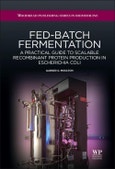- This process can be used as a teaching tool for the inexperienced fermentation student or researcher in the fields of bioprocessing and bioreactors. It is an important segue from E. coli shake flask cultures to bioreactor- The fed-batch fermentation is designed to be accomplished in a single day with the preparation work being done on the day prior- The fed-batch fermentation described in this book is a robust process and can be easily scaled for CMO production of protein product
Please Note: This is an On Demand product, delivery may take up to 11 working days after payment has been received.
Table of Contents
- List of figures and tables
- Figures
- Tables
- About the author
- 1: Introduction to fermentation
- Abstract
- 1.1 A brief history of early fermentation and the discovery of DNA
- 1.2 The rise of biotechnology I
- 1.3 The rise of biotechnology II
- 2: Generation of a recombinant Escherichia coli expression system
- Abstract
- 2.1 Plasmids
- 2.2 Cloning of foreign gene into plasmid
- 2.3 Transcription of gene into messenger RNA (mRNA)
- 2.4 Host cell
- 2.5 Transformation of E. coli
- 2.6 Making competent cells
- 2.7 Expression screening of transformed host cells
- 2.8 Bacterial growth preparation
- 2.9 Streaking and inoculating plates
- 2.10 Generation of a working cell bank (glycerol stock)
- 3: Recombinant fed-batch fermentation using Escherichia coli
- Abstract
- 3.1 Growth kinetics of E. coli
- 3.2 Reactor kinetics
- 3.3 The bioreactor system
- 3.4 Set-up and performance of a 2 liter fed-batch fermentation
- 3.5 Analysis of fed-batch fermentation
- 3.6 Sample preparation for SDS PAGE
- 4: Escherichia coli produced recombinant protein: Soluble versus insoluble production
- Abstract
- 4.1 Introduction
- 4.2 Translation from RNA into protein
- 4.3 The protein
- 4.4 Soluble protein expression in E. coli
- 4.5 The inclusion body
- 4.6 Isolation and solubilization of inclusion bodies
- 4.7 Ni purification of recombinant protein product
- 4.8 Ni purified protein
- 5: The future of Escherichia coli recombinant fermentation
- Abstract
- References
- Index








